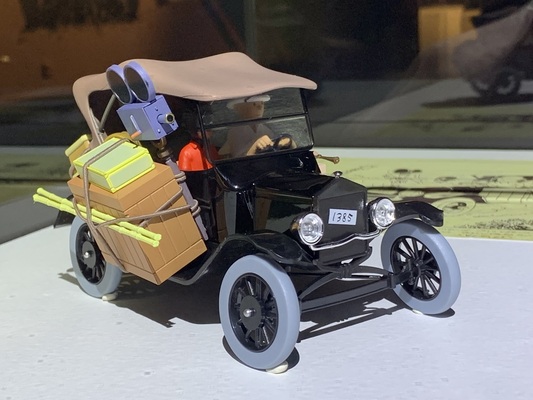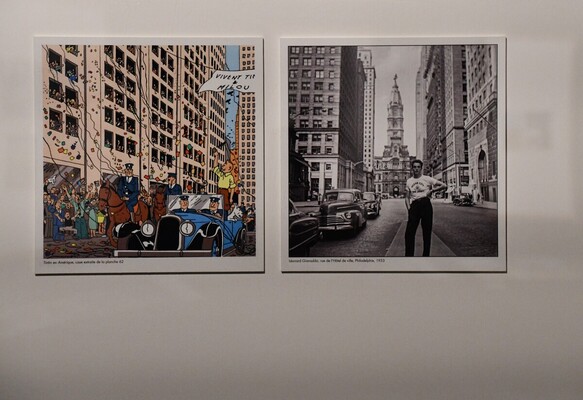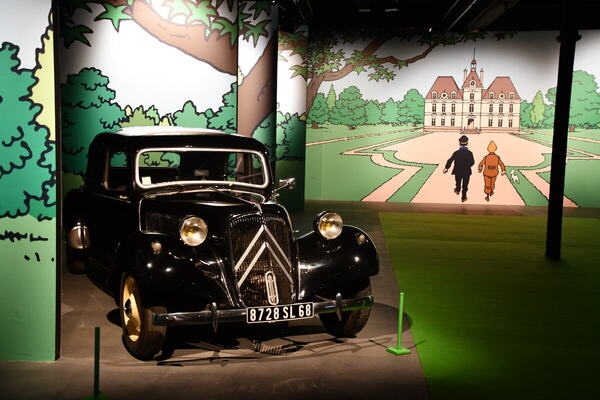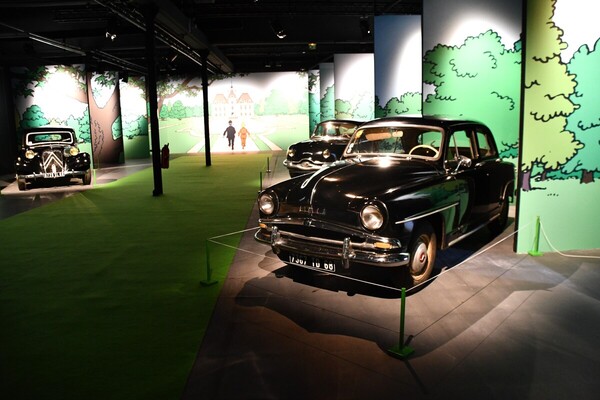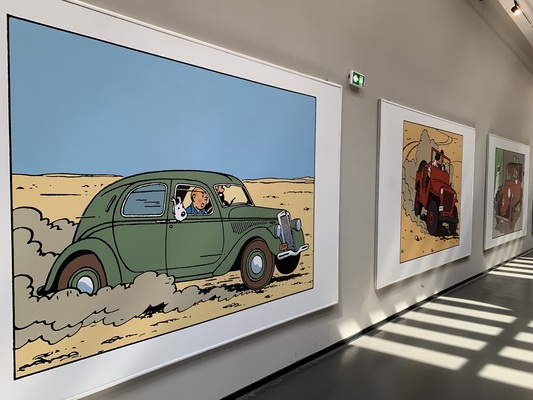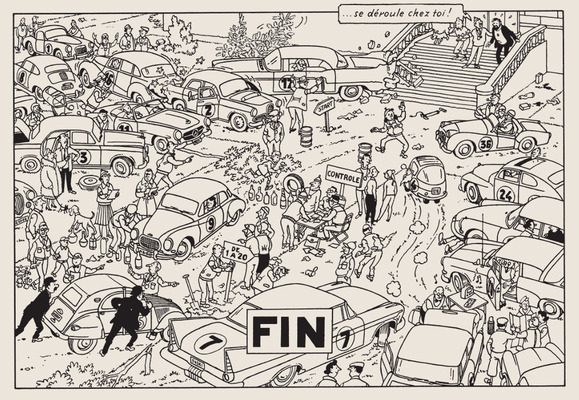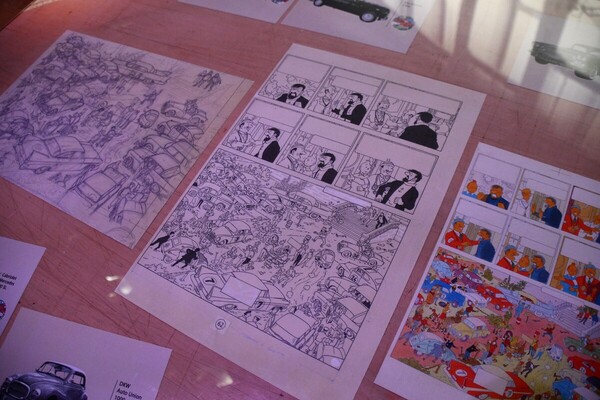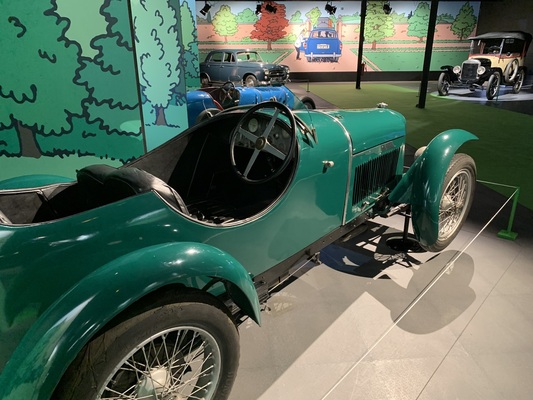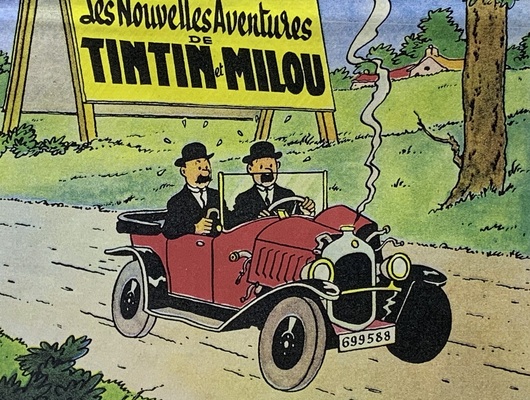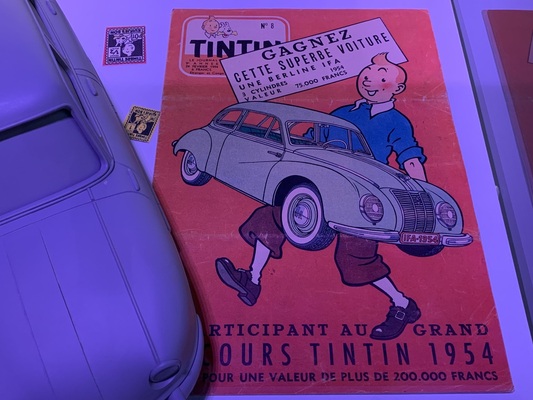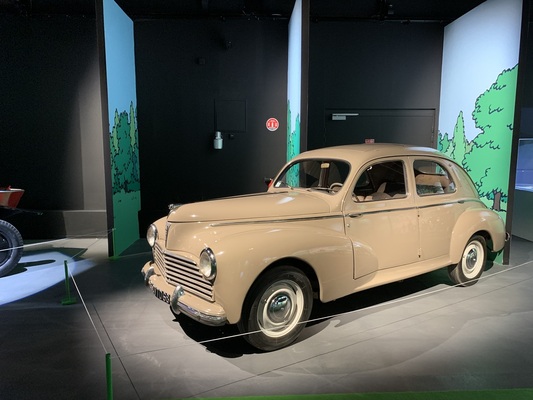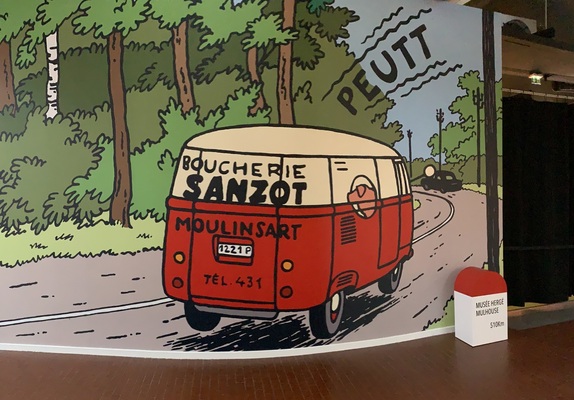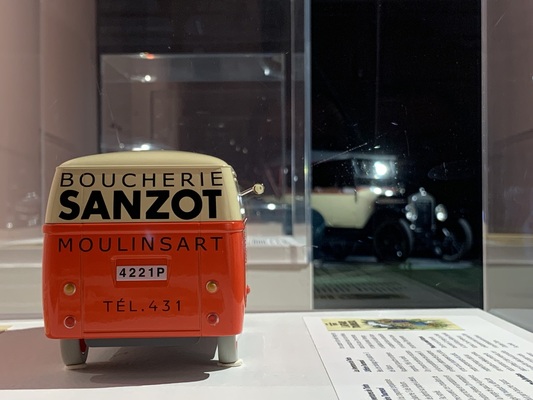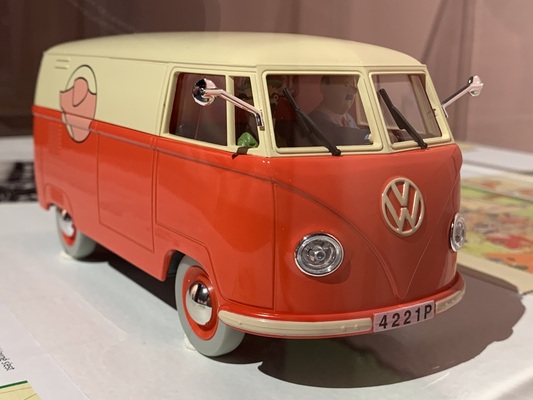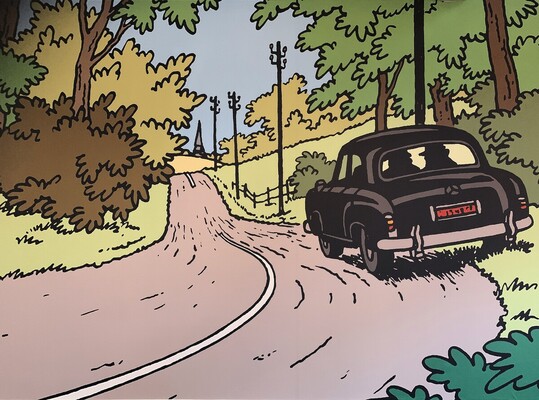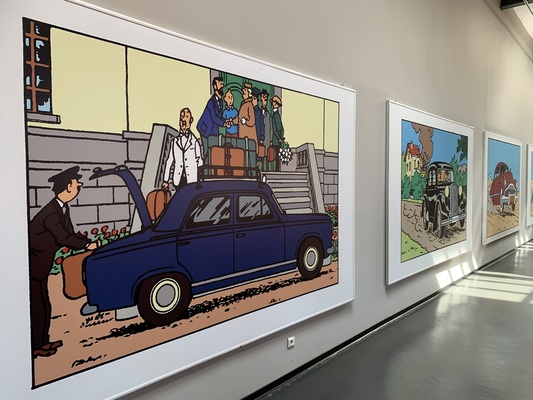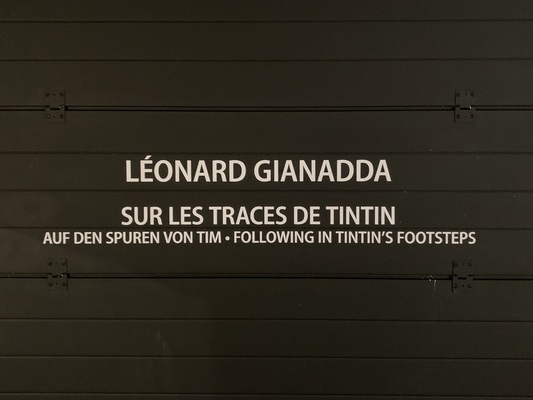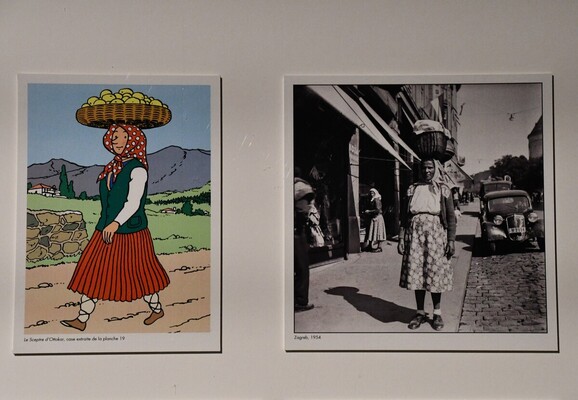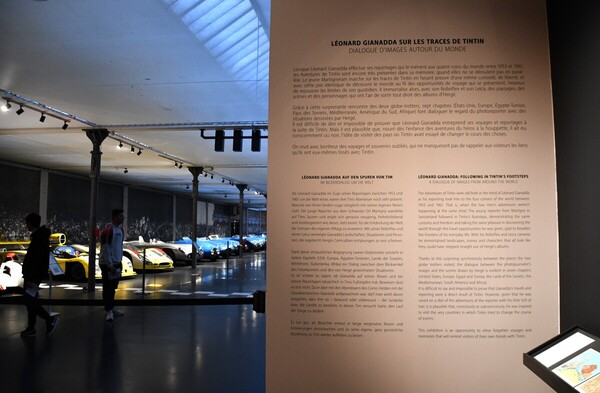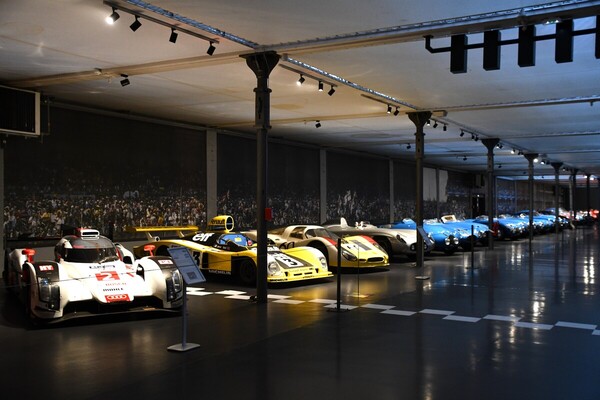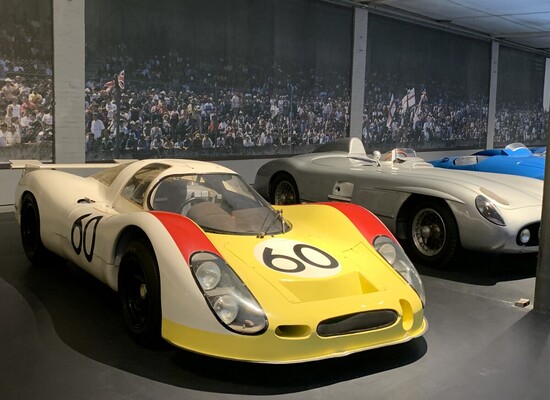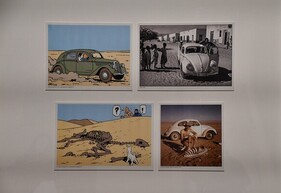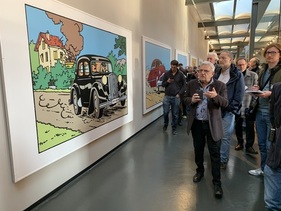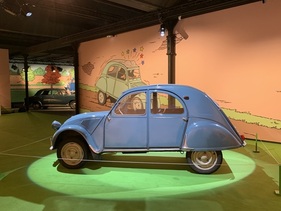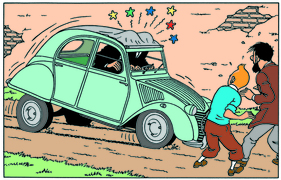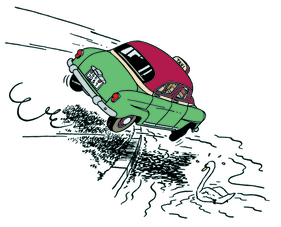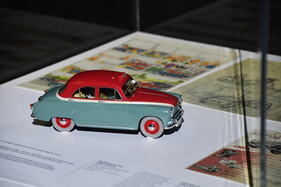From April 5 to November 11, 2025, the Musée National de l'Automobile - Collection Schlumpf in Mulhouse, just 30 kilometers from Basel, is offering a very interesting insight into the automotive world of Tintin through a unique exhibition. Entitled "En voiture avec Tintin" (In the car with Tintin), it brings together some of the most emblematic cars from the famous reporter's adventures created by Hergé.

Several personalities were present at the press visit on April 3. Guillaume Gasser, director of the museum, took the opportunity to welcome Dominique Maricq, archivist of the Hergé Foundation and author of numerous books on Tintin, and Robert Vangénéberg, administrator of Tintinimaginatio, the company responsible for the commercial exploitation of Hergé's works. We would like to remind you that Hergé, whose real name was Georges Remi (1907-1983), is the author of the adventures of Tintin, one of the most famous comic strips in the world.
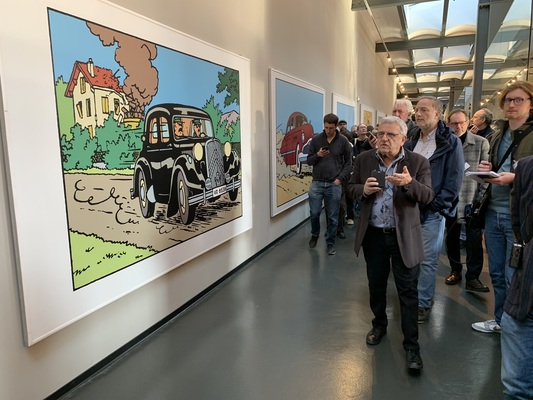
This exhibition "En voiture avec Tintin" is the story of a passion for cars that reflects an era and a culture, and which runs through the entire series of Tintin's adventures. Hergé, himself a great car enthusiast, made the vehicles into real characters in their own right, testifying to the stylistic and technological evolution of their time.

For the first time, this exhibition offers the opportunity to discover Tintin's legendary cars, staged throughout the albums using drawings, models and contemporary documents. An immersive tour that invites young and old to travel through automotive history with the famous reporter and his adventurous companions.
Hergé and the cars, a great love story
From "Tintin in the Land of the Soviets" (1929) to "Tintin with the Picaros" (1976), motorized vehicles populate the pages of every album. Each model drawn by Hergé tells us something more about his work and the exciting history of the automobile. His archives, properly organized and preserved by the Hergé Foundation, bear witness to his interest in beautiful cars. They come from France, Italy, England, Germany and the United States. In the adventures of Tintin, cars are inextricably linked to the plot and contribute to the comedy and drama of the story.

Hergé initially depicted them without any great desire for realism, but over time he developed a quest for authenticity that led him to pay particular attention to the curves of a line or even to the technical attributes of the most refined of them. Hergé himself loved beautiful cars, with a marked preference for what could only be described as "beautiful cars", including a Lancia Aprilia, two Lancia Aurelia, a Porsche 356 and several Mercedes, including a 190 SL.
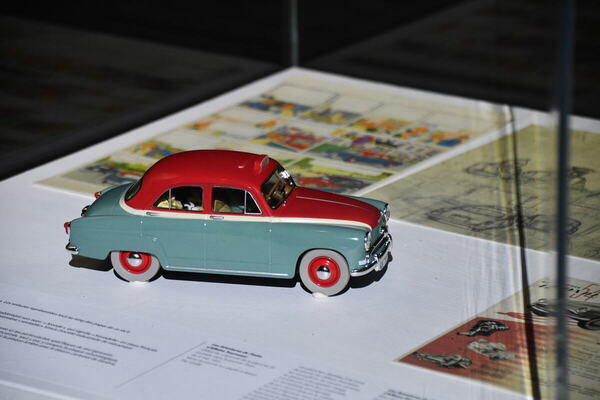
An extraordinary jewelry box
To pay tribute to this work, which has celebrated legendary cars and the 20th century so much, an exhibition venue immediately suggested itself to the initiators of the event: The Musée National de l'Automobile - Collection Schlumpf in Mulhouse. The 20,000 m2 building houses the largest automobile collection in the world with more than 600 exceptional cars, including emblematic models of the great designers who have made their mark on history in terms of both performance and mechanical progress.
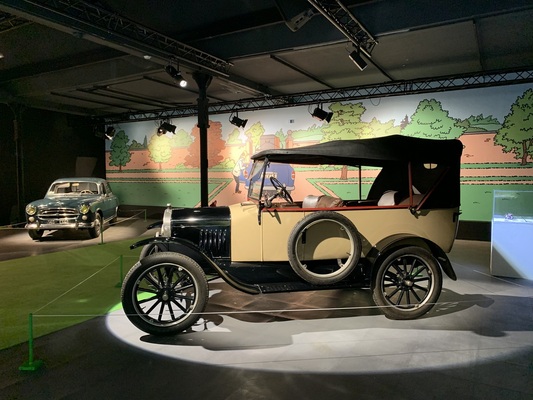
The Ford T from "Tintin in the Congo"
The Musée National de l'Automobile combines fiction and reality with this exhibition. Models of the mythical cars that populate the pages of the albums featuring the adventures of Tintin and their life-size counterparts, the jewels of the museum's collection, are displayed side by side. On display, for example, are Schulze and Schultze's 2CV in "The Bienlein Case", the Ford T in "Tintin in the Congo", Bobby Smiles' Bugatti Type 35 in "Tintin in America" and Schulze and Schultze's 5CV Trèfle from the album "In the Empire of Black Gold".
As soon as you enter the exhibition, large pictures of the backdrops and cars from the famous series line the way. Visitors are immersed in a fascinating world of boxes and speech bubbles. From the call of the big wide world to the landscapes of Mühlenhof and its famous castle, they are invited to revisit Hergé's graphic treasures throughout the stories that celebrated the car from the 1930s to the 1970s.

At each stage, Tintin's cars are presented in their narrative context, enriched by rare documents from the Hergé Foundation archives: Documentary sketches, blueprints, ink drawings, sketches, magazines, catalogs, advertising brochures, photographs, models and prototypes of vehicles.

The whole is complemented by the two magazines that alternately published the exploits of the famous little reporter: "Le Petit Vingtième" and the weekly "Tintin". The illustrators who assisted Hergé were specialists in the world of cars and played an important role in depicting all kinds of vehicles, which can be seen in "Destination Moon" and "Footsteps on the Moon", "The Little Bee Case", "Coal on Board", "Tintin in Tibet", "The Singer's Jewels", "Flight 714 to Sydney" and finally "Tintin and the Picaros".
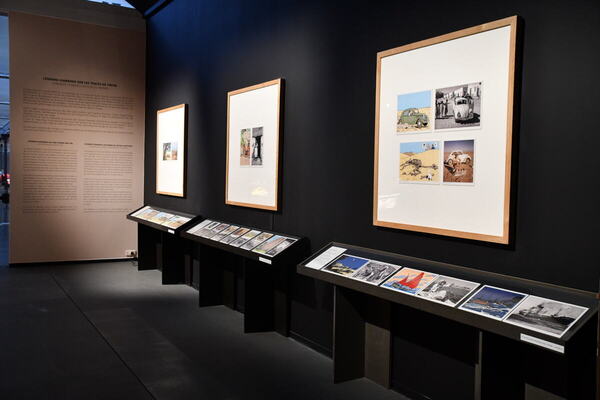
Léonard Gianadda on the trail of Tintin
As a bonus to the exhibition "En voiture avec Tintin", photographs are on display that tell the story of the journey of Léonard Gianadda from Valais, who traveled the world between 1953 and 1961. Like Tintin, he visited the USA, Europe, the Middle East, South America, Russia, Africa and the Mediterranean countries. This provides plenty of material for characters, scenes and landscapes that look as if they have sprung straight from Hergé's albums. For example, you can see a photo of Léonard Gianadda's VW Beetle in the Libyan desert next to a drawing from the Tintin album "In the Realm of Black Gold", where Tintin, also in the desert, is driving a Lancia Aprilia.
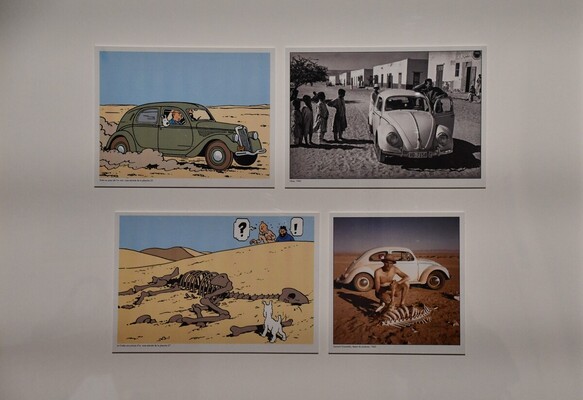
The meeting of two globetrotters, a pictorial rhyme between the real-life exploits of one and the fictional adventures of the other.

This part of the exhibition is located next to the area of the museum reserved for racing cars, in particular the Audi R18 e-tron, which won the 24 Hours of Le Mans in 2014, and a Porsche 908 driven by Jo Siffert. The latter sold several Bugattis and racing cars to the Fritz and Hans Schlumpf brothers, the founders of the museum.

After his career as a photojournalist, which he pursued while studying engineering, Léonard Gianadda set up the Pierre Gianadda Foundation in Martigny in memory of his brother. One of the strengths of this foundation is a small but fine car museum with several models driven by Tintin, including the Ford Model T from "Tintin in the Congo" and the 1929 Mercedes from "Tintin in the Land of the Soviets".
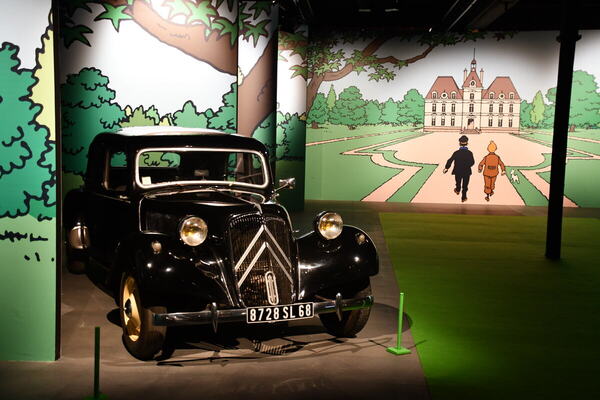
The Citroën 15 CV from the Bienlein case in Switzerland
But let's take a closer look at some of the models in the exhibition "En voiture avec Tintin".
Here we focus on the Citroën 15 CV and the Simca Aronde. Not only can both cars be found in the same album, "The Bienlein Case" (1956), but also in the same box! It all begins at Geneva-Cornavin station. For Tintin, Professor Bienlein is in danger and they must warn him immediately. As soon as he arrives, he is shadowed by secret agents sent to the scene by Borduria.
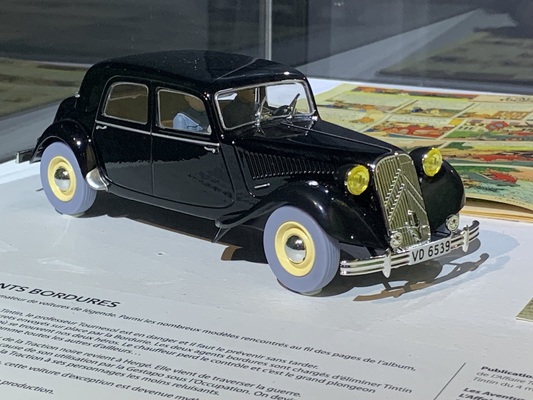
The two Bordurian agents are tasked with eliminating Tintin and Captain Haddock. A 15 CV cuts off the cab, in this case a Simca Aronde, in which our two heroes find themselves. The driver loses control and there is a big jump into Lake Geneva. But the murder attempt fails, as do all the others... The smooth, powerful and comfortable Citroën 15 CV has become a legend and perfectly symbolizes France in the 1950s.
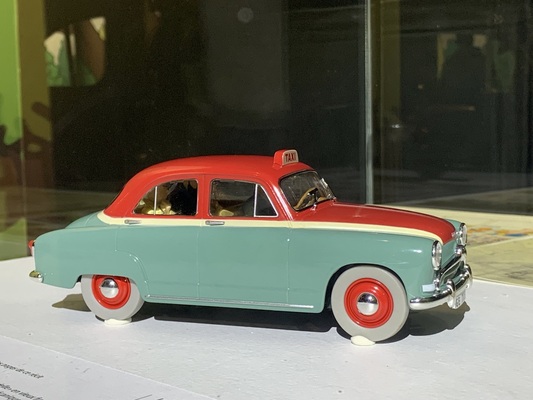
The Simca Aronde, with its soft lines and the appetite of a bird, lives up to its name: Aronde is the old French word for swallow. It is also the symbol of the Simca brand. It is considered to be the first "real" Simca, written Société Industrielle de Mécanique et Carrosserie Automobile, of which almost 1.5 million were produced between 1951 and 1963. It shows the special features of the Geneva cab from "The Bienlein Case": three-tone paintwork, logo, company nameplate, curved windscreen, chrome-plated radiator grille and built-in headlights - everything is there, including the license plate, which is also clearly visible in the album. Hergé went into even more detail and illustrated the rear license plate with the cantonal coat of arms of Geneva, the Swiss coat of arms and the four-digit license plate number.
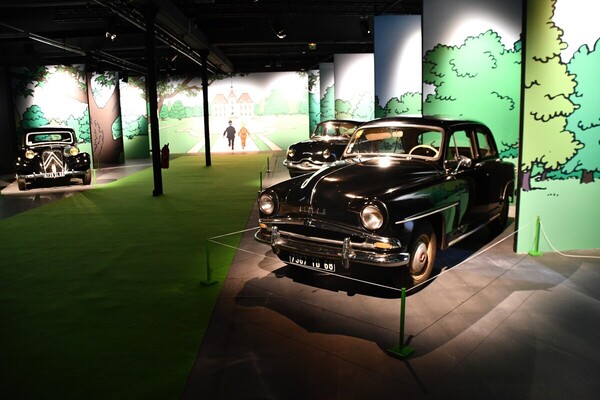
The Triumph Herald from the album "The Black Island"
Let's end this small overview with a car from an English brand, the Triumph Herald. It will only appear in the last color version of "The Black Isle". It is the only album of Tintin's adventures to have appeared in three different versions: the original black and white version (124 pages - 1938), the first color version (62 pages - 1943) and the last, completely redrawn color version (62 pages - 1966).
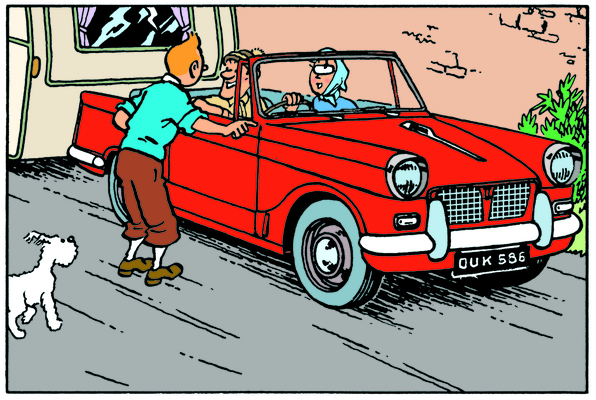
Hergé's right-hand man, the outstanding Bob De Moor, had carried out extensive research on location in England. He brought back numerous sketches and drafts from his trip, as well as catalogs, brochures, maps and postcards. The crazy journey of Tintin and Snowy remains the same in every version of "The Black Island", only the props and the environment in which the action takes place change. Apart from a few details, the convertible from the album is very similar to the reference model, the Triumph Herald Convertible.
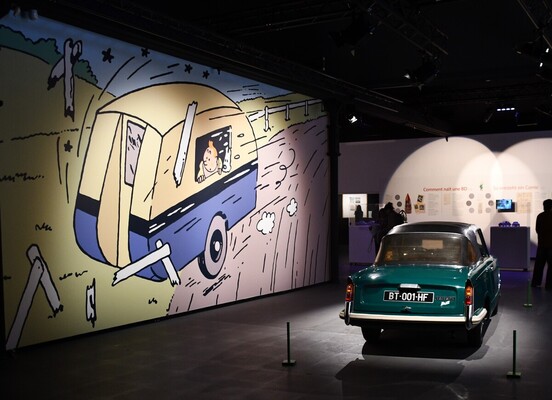
"In fact, all the vehicles in this exhibition come from our museum. This applies, for example, to the Citroën 2CV, which is the first car to greet visitors in the temporary exhibition area. The same applies to the Peugeot 403, which is displayed in front of a large-format picture from the album "The Jewels of the Singer". The Triumph Herald Convertible from the album "The Black Island" has never been exhibited before. It is part of our collection reserves," explained Guillaume Gasser, Director of the Musée National de l'Automobile à Mulhouse.

The secrets of production
In the second part of the exhibition "En voiture avec Tintin", visitors will go behind the scenes with a reconstruction of Tintin's father's office, at the heart of the Hergé studios founded in 1950. Surrounded by skilled illustrators and equally skilled colorists, Hergé developed a series of processes and procedures that led to a kind of graphic perfection rarely achieved in the past. It is characterized by the systematic use of pencil drawings in the same format (300 x 500 mm on average) before the line drawings follow.
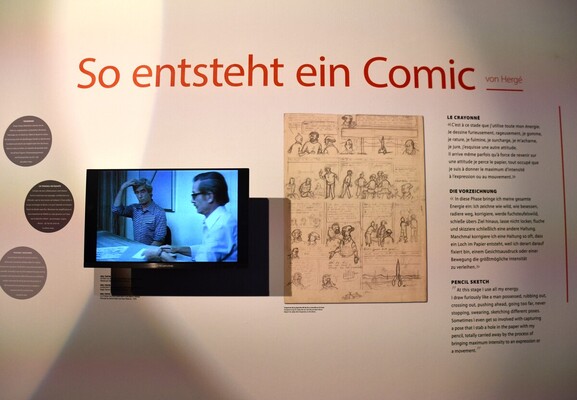
The small group of illustrators around Hergé is now perfectly structured; everyone knows their role in the creation process of the Tintin albums or the associated merchandising products. In this meticulous construction site that strives for excellence, Hergé remains the sole master of the house. The other members of the team are primarily there to support him.

Hergé's Opel Olympia
As already mentioned, Hergé was a great car enthusiast. However, it should be added that several cars he acquired were featured in the Tintin albums. For example, the Opel Olympia Cabriolet in "King Ottokar's Sceptre", the car of the Syldavian spies, is the same car that Hergé owned at the time. He actually bought his first car in 1938 at the age of 31. "I bought it from the Paul Cousin establishments. During the war, I hid it in a barn because the Germans confiscated cars. So I didn't drive it much. Besides, the gasoline was almost impossible to find. Then I lent it to a doctor... During the liberation, it was bent a little by a big American truck...", Hergé recounted at the time.
Few people know that Hergé was also the owner of an Imperia Mésange, which he drew in "The Crab with the Golden Scissors" and which was towed away by a tow truck. A 1940 model that he had bought second-hand. The Imperia automobiles were manufactured in Nessonvaux, Belgium, and the Mésange model was an Adler that had been built under license before the war (1932).
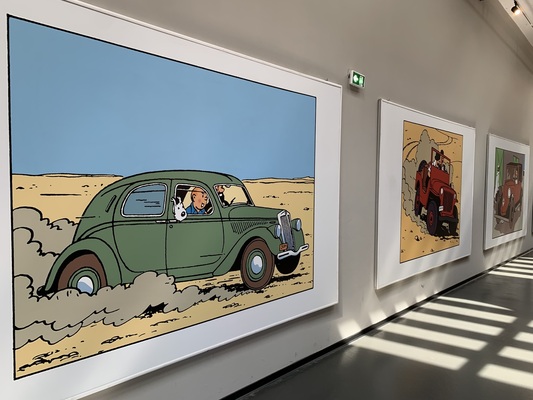
The Emir's Lancia Aprilia and Hergé's Porsche 356
In the album "In the Realm of Black Gold", Tintin drives the Lancia Aprilia of the Emir Ben Kalish Ezab. Hergé had acquired a right-hand drive car of the same model, which he inaugurated on his way to Switzerland. The illustrator also drove a blue Porsche 356, which appears discreetly in the large automobile assembly of the "Volant Club" rally and is visible in a splendid panoramic panel of the album "Coal on Board", in this case in the last panel on page 62 (it bears the number 8).
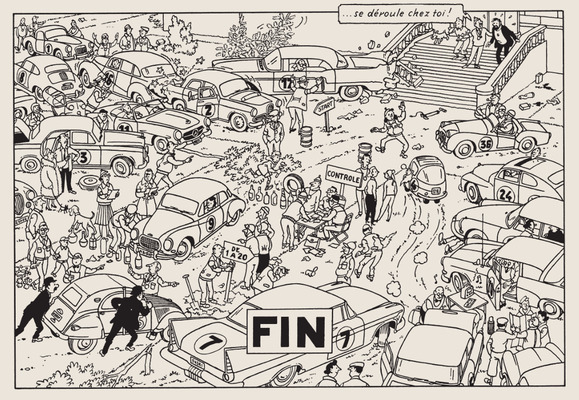
The "En voiture avec Tintin" exhibition is also dedicated to the documentary part of the Hergé studios, a crucial element in the creation of the adventures of Tintin. In this context, Hergé testifies: "So it was at the time of the "Blue Lotus" that I discovered a new world. I discovered a civilization that was completely unknown to me, and at the same time I became aware of a kind of responsibility. From that point on, I began to look for documentation, to take a real interest in the people and countries I was sending Tintin to, out of honesty towards those who were reading me."

Specifically, Hergé's employees fed the studios' dossiers with various documents on a wide range of topics. The section on cars contains numerous press clippings, photos and illustrations. Some of them can be seen in the showcases of the exhibition. However, it should be noted that Hergé did not wait for his studios to be founded to create his database. As early as the 1930s, he began to collect numerous references that could help him in his creative work. His work in the editorial department of the Brussels daily newspaper "Le Vingtième Siècle" gave him access to numerous photos from national or international press agencies.
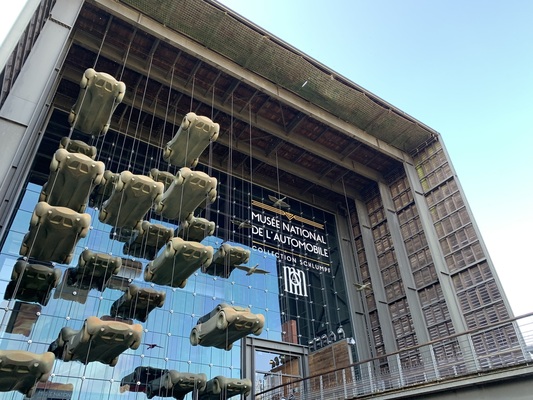
Information on the exhibition, visiting times and admission prices are published on the museum's website .












